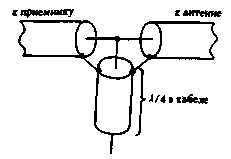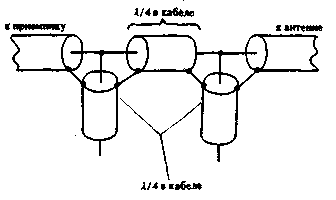
|
|
ENCYCLOPEDIA OF RADIO ELECTRONICS AND ELECTRICAL ENGINEERING Ways to eliminate interference. Encyclopedia of radio electronics and electrical engineering
Encyclopedia of radio electronics and electrical engineering / Knots of amateur radio equipment. Filters and matching devices At present, the issue of noise immunity of radio receivers has become aggravated. This is due to the fact that old broadcast transmitters are being modernized and, as a rule, “powered up”, new departmental broadcasting and communication radio stations are being opened, and a cellular communication network is being developed. For example, in Belgorod, a broadcasting station operating on 1600 kHz blocks simple receivers on the 160-meter band, departmental stations give strong interference on the 30-, 80- and 40-meter bands. VHF intercom systems interfere with 144 MHz operation. Powerful VHF broadcasting signals "clog" weaker VHF signals from other cities - Kharkov and Stary Oskol. VHF communication systems operating in the frequency range of about 50 MHz interfere with the observation of amateur stations on this interesting band. The reserves for increasing the dynamic range are limited, and the only way that is possible in this case to ensure the normal operation of the receiver is to reduce the level of interference at its input. Elimination of interference in the ranges of CB - KB The simplest filter, which attenuates useful signals by about 3 - 10 dB, more at low frequencies and less at high frequencies, is shown in Fig. one.
It consists of two or three turns of communication, located one inside the other. With the help of such a filter, interference from powerful LW-MW stations can be significantly attenuated. In severe cases, you can try to use notch filters, ie. filters tuned to a specific interfering signal. The simplest filter looks like shown in Figure 2.
It is a circuit tuned to the frequency of the interfering station, included in the antenna circuit. The best option is if the loop condenser is air. You can combine the methods shown in Figs. 1 and 2. The rejection band of carefully made contours can range from 10 kHz, at 1,6 MHz, to 500 kH, at 30 MHz. Filters are reversible, i.e. theoretically, there is no difference where to connect the antenna and where - the receiver, but in practice it may turn out that there will still be a difference, albeit a small one. Structurally, these filters are made in fiberglass, carefully soldered boxes; after adjustment, it is useful to close the filter with a lid and carefully solder it. In some cases it may be necessary to use adjustable attenuators. To do this, it is convenient to use the device shown in Fig.3.
It consists of two identical coils with a diameter of 15 mm, having 5 - 10 turns and located parallel to each other, between which a damper made of foil fiberglass rotates. With a perpendicular position of the damper relative to the turns of the coils, the attenuation is minimal, with a parallel arrangement, it is maximum. This attenuator provides an initial attenuation of 3 dB and a final attenuation of 20 to 40 dB, depending on the range, it works "softer" than an ordinary resistor attenuator. With a large number of interfering stations, the best way out is to use band-pass filters. The circuit used in the band filter should be as good as possible. It should be noted that it is not recommended to use coils on ferrite cores in both notch and band filters. The use of coreless coils implies that they must be made of thick wire, and that the capacitors used in these circuits must be with an air dielectric. I have tried a simple band pass filter that uses only one variable capacitor, and this filter has a rather narrow bandwidth (Fig. 4).
It is a tunable circuit placed in a fiberglass box, at the two ends of the coil there is a connection loop: one - with the antenna, the other - with the receiver. It is desirable to use a capacitor with a maximum capacitance of not more than 100 pF. It is also possible to include notch circuits in such a filter, as in Fig.2. Elimination of interference from VHF stations Filters made on lumped elements, it is difficult to achieve acceptable parameters when working on VHF. But even on VHF, the need for notch filters is high. For example, in Belgorod the local TV center operates on TV channel 6, while the Kharkiv "commercial" TV center operates on TV channel 7. As a result of blocking by the local television center, reception of the Kharkiv television center in areas near the TV tower is impossible. In such cases, a notch filter on long lines can be useful. It is a segment of a coaxial cable with a length of a quarter wave of the interfering channel (Fig. 5) that is connected in parallel to the input of the TV receiver and is open at the end.
Such a length of cable is almost a short circuit not only for its resonant frequency, but for all its odd harmonics. If one piece of cable is not enough for a satisfactory rejection of the interfering signal, you can turn on another such piece after a quarter of the wavelength, etc. (Fig. 6).
When calculating, the wave shortening factor in the coaxial cable should be taken into account. For a conventional cable with polyethylene insulation, this coefficient is 0,66. To adjust the filter by shortening the cable, it is advisable to use a cable segment with an initial length slightly longer than the calculated one. Departmental VHF stations operate in the range of approximately 130 to 170 MHz. If it is not possible to accurately know the frequency of such a transmitter, you can use a custom filter (Fig. 7).
It is a piece of cable about 1,5-2 times less than a quarter of the expected wavelength for which this filter is designed. For example, in order to carry out notching in the range of 130-170 MHz, the length of the cable segment must be within 15 cm. The capacitor must be necessarily air with a capacity of about 2 ... 20 pF. Notch filters made of cable can also be used for the MW-HF range with very good effect if enough cable is available. In this case, it is desirable to make them adjustable, as in Fig. 7. Filters with coaxial notches can also be turned on at the output of the transceiver by tuning some of the notches to an interfering signal, and some of the notches to the frequency at which the transceiver creates interference. In this case, when receiving, we get rid of the interfering station, and when transmitting, we get rid of interference to neighboring receivers. Author: I. Grigorov (UZ3ZK), Belgorod; Publication: N. Bolshakov, rf.atnn.ru
Machine for thinning flowers in gardens
02.05.2024 Advanced Infrared Microscope
02.05.2024 Air trap for insects
01.05.2024
▪ Ultrasound helps drugs reach their target ▪ Mystery of the Chameleon Spider ▪ Vinyl record sales surpass CD sales for the first time
▪ section of the site Assembling the Rubik's Cube. Article selection ▪ Article Atmospheric pressure. History and essence of scientific discovery ▪ article Where is the Ice Cream Graveyard located? Detailed answer ▪ article Freeberry prickly. Legends, cultivation, methods of application ▪ article Runner plate repair. Encyclopedia of radio electronics and electrical engineering
Home page | Library | Articles | Website map | Site Reviews www.diagram.com.ua |






 Arabic
Arabic Bengali
Bengali Chinese
Chinese English
English French
French German
German Hebrew
Hebrew Hindi
Hindi Italian
Italian Japanese
Japanese Korean
Korean Malay
Malay Polish
Polish Portuguese
Portuguese Spanish
Spanish Turkish
Turkish Ukrainian
Ukrainian Vietnamese
Vietnamese







 Leave your comment on this article:
Leave your comment on this article: